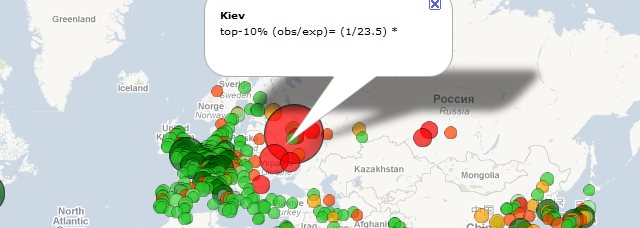The citation index of scientific articles in the CIS is extremely low

On duty, I have to read quite a few English-language articles on geo-informatics and various GIS (and at the same time I am completing my thesis, where I have to work very carefully with sources and references to various authors). Suddenly, in the course of this work, I came across an extremely curious example of using Google Maps for purposes of interest to me with a map theme that vividly illustrates the state of science in the countries of the former CIS.
So, in the study “Which cities produce expected?
A new mapping approach — using Google Maps — based on statistical significance testing ”( pdf ), analyzes the frequency of citation of scientific articles in physics, chemistry, and psychology throughout the world in 2008. The document itself is very detailed, quite sensible arguments are given regarding the “weight” of a scientific article as a number of “referents” to it (by the way, there are no references to the Google search engine ranking algorithm), and links to the authors' personal pages can be easily found on the Internet. Thus, the question of the objectivity of the study, of course, remains open, but the facts in it speak for themselves.
')
Under the cat a brief overview of the document and a link to the map .
If the number of articles cited in the city (which is recognized as such, if there are 8 or more references to it) exceeds 10% of the total number of published articles, then the city is shown in green on the map, otherwise - in red or by its gradations. Analysis of the map leads to sad conclusions (I will do it only for Ukraine for obvious reasons) - articles from Kiev, Lvov and Kharkov (my hometown is not on the map for some reason, perhaps it should upset even more) nobody cares. Moreover, Kiev is in this sad ranking immediately after Moscow, and it turns out that the level of scientific research in the CIS is so low that referring to an article by a scientist living somewhere that speak Russian or Ukrainian will soon be considered bad in a tone.
Source: https://habr.com/ru/post/120165/
All Articles